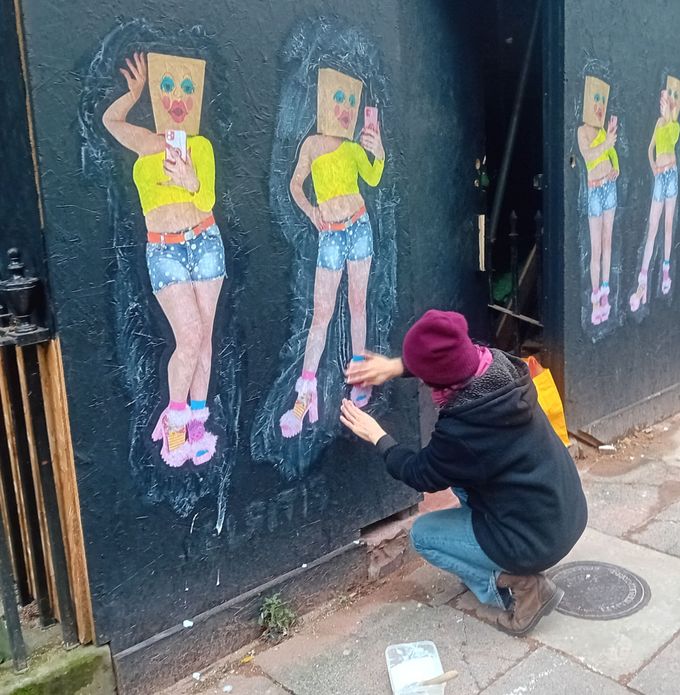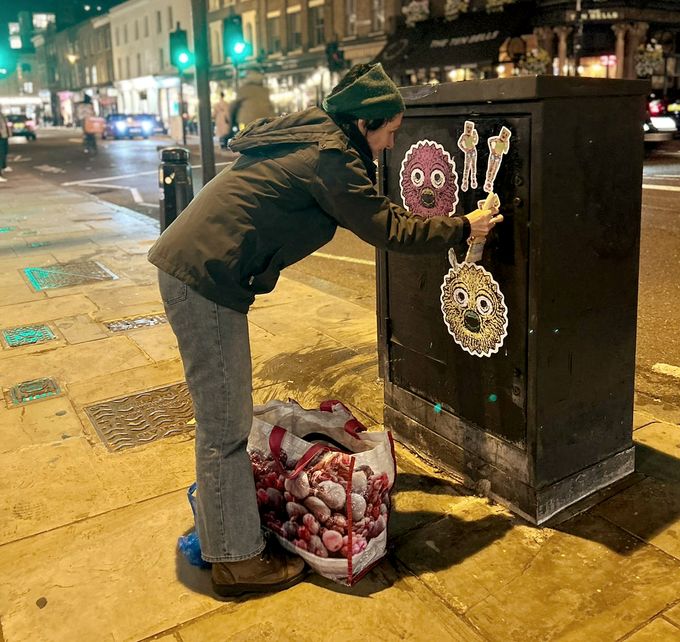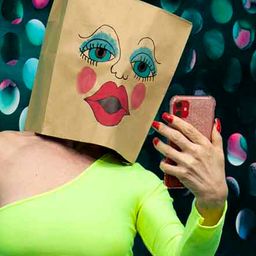At the moment the thing I enjoy most in the entire universe is working as a life model. However, I am approaching an age that makes me wonder for how long I will be able to sustain myself solely through this profession to pay my bills. In an ecosystem where demand is high, especially for young and beautiful individuals (and even better if you’re young, beautiful, and female), growing old isn't always simple.
During one of these existential crises in 2022, I considered that perhaps it was time to use some injectables to help my face. However, I thought it wasn't very smart to immediately spend £700 on chemicals to fill my whole face without first testing if my body would accept it without any adverse reactions.
I had three days off of work for the Easter break when I visited an aesthetic/beauty centre to inquire about a small test of filler to make my lips more symmetrical (I have very asymmetric lips that I really hate!). I wanted to give my body a chance to acclimate. I explained to the therapist that I work as a life model and that I have to be very cautious about any changes to my face, as it could disturb artists drawing me with bruises. Due to this concern, she decided it was best to avoid the test, as apparently lips are the most susceptible to bruising. I left feeling disappointed. Once back home, I began researching dermal filler treatments and discovered a fascinating world that made me feel, to say the least, naïve. During my research, I discovered that those beautiful lips that seem ready to give you a kiss and those high cheekbones are not evolutionary features (as I thought...), but rather the result of injectable treatments.
As I went through all these photos, I noticed that the beautiful images of attractive ladies on Instagram were all very similar: similar features and similar poses.
I also began reading articles and blogs about how to take the best selfie, and I stumbled upon a page titled 'Selfie Statistics, Demographics, & Fun Facts (2022)'.

92 million selfies are taken every day
The page stated that; 92 million selfies are taken every day, that on average Millennials will spend over 10 years of their lives taking selfies, that there has been a 13% increase in requests for plastic surgeries by people wanting to look like their filtered selfies and that drowning is the primary cause of death while taking selfies. Apparently more people die from taking selfies than from shark attacks...
At that point, I didn't realize it, but I was starting to go down a rabbit hole that would take almost 2 years of my life. It led to the development of a multidisciplinary art project titled 'Bag Lady,' which later expanded into an interconnected project titled 'Selfitis.' Exactly, a two-year journey that shed light on the pervasive social media addiction within our society as a whole.
At this point, it's important to mention that when I'm not working as a life model, I am engaged as a creative practitioner focusing on conceptual art. The core of my artistic practice revolves around researching shared human experiences and addressing contemporary concerns. I work at the intersection of visual art, performance, and activism, aiming to raise awareness and provoke thought on important societal issues of our time. But after this aside, let's return to our addiction to social media...
At that point, my mind was ablaze, trying to find a way to proclaim to the world that all the time we're wasting to generate free content for social media platforms is absurd! I've read about children dropping out of school because they were too engrossed in taking hundreds of photos every day, hoping to find one or two good enough to share with their global audience! And the 'Bag Lady' arrived to me.
I've been mad enough to collect clothes since I was 10 years old
It so happens that I've been mad enough to collect clothes since I was 10 years old, so I came up with the idea of wearing 365 outfits and posting 365 selfies on Instagram, one each day for an entire year, while covering my face with a paper bag. On the bag, there's a stylized drawing of a face with makeup. The concept was to engage in one year of social media activism, accompanying each image with the haunting statistics I found online, in an attempt to test on myself the psychological effects of spending about 5 hours a week taking, editing and posting selfies. Well... the effect was very negative. I started to become overly concerned about my appearance (even with a bag on my face...) and felt extremely frustrated because my posts weren't receiving the feedback I expected. Despite having over one thousand followers, Each post only received an average of 50 to 70 likes with minimal interaction (I am very grateful to the few people who shared their thoughts and feelings). Instead, I received numerous comments and direct messages from bots asking for money to boost my posts.

Due to this frustration, I decided to take the 'Bag Lady' concept to the streets to engage with people. I dressed her in a very glamorous manner (a tiny red sequin dress and very high heels) and wrote 'LIKE ME', 'FOLLOW ME', 'CONSUME ME' on the front and back of my limbs, along with my Instagram handle @justlidialidia. She wandered around, and every 4 or 5 steps, she snapped a selfie regardless of her surroundings. This brought me extraordinary joy: finally, I was able to converse with people who, generally were just trying to take a selfie with her, but occasionally shared their thoughts with me about the phenomenon of taking selfies and the pressure of portraying a glittery perfect life on social media.
the media coined the term 'selfitis' as a hoax to describe an obsessive-compulsive desire to take photos of oneslef.
Meanwhile I continued my research, attempting to understand the extent of the problem. I discovered that research increasingly linked heavily filtered selfies to increased body dissatisfaction, leading to the emergence of a new term: Snapchat dysmorphia. This is a body dysmorphia resulting in a subsequent rise in requests for plastic surgeries by individuals wishing to resemble their filtered selfies. Additionally,I discovered that in 2014, the media coined the term 'selfitis' as a hoax to describe an obsessive-compulsive desire to take photos of oneself and post them on social media.
In November 2022, a youth mental health charity published a study warning that social media represents a significant risk to the current and future mental health of today’s young generations. Consequently, I decided that my work needed to transform into a national campaign to raise awareness about this problem during Mental Health Awareness Week in May 2023. As part of this initiative, the Bag Lady became the main character for what was intended to be a billboard and a social media campaign on Instagram titled 'Selfitis'.
Initially, I applied for funding with the Arts Council, but my project was rejected. Undeterred, I chose to self-fund the campaign. However, finding an appropriate space for a 48-sheet billboard in portrait orientation proved challenging, especially as I preferred a static billboard over a digital screen. Eventually, I secured a suitable space in Dalston and agreed with the advertising company to pay £1000. However, when the person in charge saw the artwork, they responded, 'Unfortunately, I am unable to run that content, which may be considered controversial by some.'
We reviewed your business account, and determined that it does not comply with our terms, including our commerce eligibility requirements
After experiencing days of tears and disappointment, I decided to invest £2000 in running a 'solid' campaign on Instagram. Within 10 minutes of opening my META business account, I received an email stating, 'We reviewed your business account, Lidia Lidia, and determined that it does not comply with our terms, including our commerce eligibility requirements. Because of this, your business account may be restricted from advertising.' I promptly requested a review and submitted my passport and photos for identity verification. However, after two months, the request was still pending, and my account remained restricted. Despite multiple attempts to resolve the issue, including further review requests and identity verification submissions, my account status remains unchanged, and the verification process is still pending.
And again... more tears and at this point rage. I was literally furious! What was I doing against Meta policy? All my work is about human rights and social justice...

I decided to print the main image of the campaign and paste it all over London during Mental Health Awareness Week. In hindsight, it was possibly the best thing I could have ever done!
Between May 15th and 21st, every night, I ventured out on my bike with my bucket of glue and some cutouts, pasting about 300 pieces throughout London. I didn't know much about street art, so I tried to paste where it seemed I wouldn't damage buildings. Initially, I focused on corners of fly-posting adverts, being careful not to cover their content. In my simple mind, I believed the unusual image of the Bag Lady would attract more attention to the adverts. However, I soon realized that not everyone shared my perspective.One night in the Brick Lane area, I encountered a man who was extremely upset with me for pasting on the corners of his adverts. Initially intimidating, he eventually shared with me the struggles his son faced due to social media situations. After about an hour of conversation, he even hugged me and helped me to paste one of my Bag Lady images (though not on his advert).
Within a few days after Mental Health Awareness Week had ended, I began receiving direct messages from people who had seen my work on the streets. Some simply reached out to express that my work had brought a smile to their face, while others shared their personal stories.
I heard from individuals struggling with their own mental health due to the pressures of social media, parents who shared heartbreaking accounts of their children's experiences, and even teenagers who recounted stories of friends who had tragically taken their own lives after being bullied for their appearance, losing touch with reality as a result.
But the most amazing thing was being introduced to the extraordinary community of street art. People from London's street art scene began tagging my work in their Instagram posts. One of them, Slow Shrug, not only supported me with advice, but he also went the extra mile by inviting me to his girlfriend's birthday party, introducing me to something entirely new: a collective of passionate, creative individuals who, instead of competing with each other, took pride in supporting one another, sharing moments of public art. They all revolved around the London Paste Up Festival and their hyper-productive and super friendly leader, Apparan, a very dynamic woman involved in socially engaged art projects all over London.
The impact of this meeting was profound, and I decided that I wanted to continue putting my art in the streets because it's the best and most democratic gallery imaginable. It's exhilarating to have something to say and to know that your message can reach not just someone, but everyone. In this ecosystem, there are no gatekeepers deciding the value of work based on inexplicable speculation. It's a place where everyone's creativity and messages are welcome, as long as there's a code of respect for everyone's work, acceptance for diversity and inclusivity.
Human beings are inherently social and creative beings
The unwritten code of respect and support for everyone's creativity, regardless of medium, without a sense of competition dictated by the economic system, made me reflect deeply on the vital necessity of human beings to be creative. Human beings are inherently social and creative beings, and these two aspects are interconnected.
My project 'Selfitis' concluded in August 2023 when I applied to an open call and was awarded a billboard in New York, but meanwhile my awareness of the world underwent a profound transformation. Our world is transitioning from the physical to the virtual realm, and as a result, our collective reality and perception are rapidly evolving, leading to significant mental health challenges for many. In this moment of transition, our species needs free 'real' spaces to communicate more than ever. Because of my experience, I invite everyone to consider an alternative that isn't based on the ephemeral hope of becoming famous in a global world through the internet.
While you're waiting for this validation, give body to your creativity and share it with others in the streets. If you're based in London, the Brick Lane gallery is always open, and based on my experience, it will welcome you no matter your medium, age, gender orientation, or ethnicity, as long as you're respectful of everyone else.
Unfortunately the issue I tried to tackle is here to stay for a while.
Unfortunately, the issue I tried to tackle with 'Bag Lady' and 'Selfitis' is here to stay for a while. I'm considering pasting more Bag Lady pieces, so if you find me and there's space, put your work close to mine, post it tagging me, and I'll repost you in my story because supporting each other is the secret to living a serene, fulfilling life!
It is important to ensure that digital technologies don't impact negatively on our mental, physical and emotional health. To do so we need to find a correct balance between our 'real' and 'online' lives. For more information on digital wellbeing visit the digital wellbeing website
Because the mass adoption of social media is a recent phenomenon, more research is needed to define the full impact of the consequences of it's use. However, different studies have found a link between heavy use of social media and an increase of mental problems such as depression, anxiety, self harm and suicidal thoughts.
To find help visit:
For other helpful information visit

